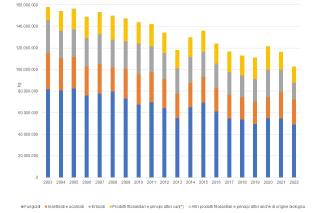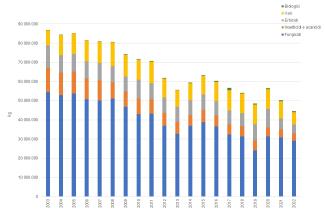Panel 1
Valter BELLUCCI, Sonia ROSSI (ISTAT), Giovanni SERI (ISTAT)
In 2022, approximately 103 thousand tonnes of plant protection products (PPPs) were placed on the market, containing around 44.5 thousand tonnes of active substances.
Compared to the previous year (2021), sales of PPPs declined by 11.6%. A similar decrease was recorded in the volume of active substances, which fell from approximately 50 million kilograms in 2021 to 45 million in 2022 (-11.5%). Consequently, the quantity of active substances distributed per hectare also decreased: from 4.0 kilograms per hectare of Utilised Agricultural Area (UAA) in 2021 to 3.6 kilograms in 2022.
Over the broader period from 2014 to 2022, the PPP market experienced a contraction of -20.8%. Active substances declined by 25.0% relative to 2014, the year the previous National Action Plan (PAN) for the sustainable use of PPPs entered into force—currently undergoing advanced revision. Trends vary by product category: active substances in fungicides declined by -21%, insecticides and acaricides by -32.3%, herbicides by -40.8%, and miscellaneous products by -26.5%. In contrast, biological products showed a notable increase of approximately 59% since 2014; however, they still represent only a minor market share of 1.1% of the total.
The indicator allows for the assessment of the annual quantities of plant protection products (PPPs) released for agricultural use, as well as the comparison of distribution patterns over time and across regions. The data used to construct the indicator are provided by ISTAT and originate from a census-based survey conducted annually among companies in Italy that distribute PPPs under their own or foreign brands (survey included in the National Statistical Plan – IST-00168).
The ISTAT data take into account products designed to protect plants or plant products from harmful organisms (such as fungi, insects, mites, bacteria, and viruses) and from weeds, as well as products intended to promote or regulate plant physiological processes—excluding fertilisers.
The data are analysed according to the different types of products distributed (fungicides, insecticides and acaricides, herbicides, miscellaneous, biologicals, and traps) and the active substances they contain, which are responsible for the direct action against the targeted threats. Furthermore, the quantities are expressed in relation to the treatable area, which includes arable land (excluding fallow), kitchen gardens, and permanent woody crops.
Representation of the quantities of plant protection products (PPPs) distributed for agricultural use and evaluation of their distribution dynamics at national and regional level. The indicator supports a comprehensive overview of the environmental issues associated with the distribution of these products.
- Directive 2009/128/EC establishes a framework for Community action aimed at the sustainable use of plant protection products (PPPs).
- Directive 2009/127/EC concerns machinery for pesticide application, while Regulation (EC) No 1185/2009 relates to pesticide statistics.
- According to Presidential Decree (DPR) No. 290/2001, Article 42(3), purchasers and users are obliged to compile and retain a field diary (also referred to as a "treatment log" or "farm record book") on the farm, in which all plant protection treatments carried out during the growing season must be recorded.
- Implementing Regulation (EU) 2022/1252 provides a list of active substances identified as candidates for substitution, published in Official Journal No. 191/41 of 20/07/2022.
EU policy aims to reduce the use of active substances that are harmful to the environment and human health, and to replace them with safer alternatives, while promoting the adoption of low-impact agricultural techniques.
📌 The EU Biodiversity Strategy for 2030 sets the following targets:
- Convert 10% of agricultural land into high biodiversity areas.
- Halt and reverse the decline of farmland birds and insects, especially pollinators.
- Reduce the overall use and risk of chemical pesticides and cut the use of the most hazardous pesticides by 50%.
- Allocate at least 25% of farmland to organic farming, with a significant expansion of agroecological practices.
🥬 The Farm to Fork Strategy — a comprehensive EU framework for building a fair, healthy, and environmentally friendly food system — is the first to address the entire food value chain. One of its key quantified objectives is to: Halve the use and risk of chemical PPPs by 2030.
Panel 2
ISTAT, 2024, Noi Italia 2024 (https://noi-italia.istat.it/pagina.php?id=3&categoria=11&action=show&L=0)
ISTAT, 2019, La distribuzione per uso agricolo dei prodotti fitosanitari. Annata di riferimento agraria 2017. Statistiche report (https://www.istat.it/it/archivio/216611) http://dati.istat.it/
ISTAT, 2015, La distribuzione per uso agricolo dei prodotti fitosanitari. Annata di riferimento agraria 2013 Statistiche report (https://www.istat.it/it/files//2015/01/Fitosanitari-e-fertilizzanti.pdf)
ISTAT, 2012, La distribuzione per uso agricolo dei fertilizzanti. Annata di riferimento agraria 2010. Statistiche report. (http://www.istat.it/it/archivio/108926)
ISTAT, 2011, La distribuzione per uso agricolo dei prodotti fitosanitari. Annata di riferimento agraria 2010. Statistiche report.
ISTAT, 2011, Utilizzo dei prodotti fitosanitari nella coltivazione della vite - Annata di riferimento agraria 2009-2010. Statistiche in breve, agricoltura ISTAT, 2012, 6° Censimento generale dell’agricoltura. www.istat.it
ISTAT, 2010, La distribuzione per uso agricolo dei prodotti fitosanitari. Annata di riferimento agraria 2009. Statistiche in breve, agricoltura
Since the data do not refer to actual use by agricultural operators, it is not possible to quantify the utilisation of plant protection products across different crop types, to account for environmental factors that influence their agricultural use, or to analyse their impact on the environment and human health. Moreover, the data are collected from distributors (who may also be producers), and the quantities distributed are treated as a proxy variable for products sold, and thus for those effectively used.
To enhance the relevance of the indicator, it is recommended to complement it with reliable data on the actual quantities of plant protection products (PPPs) used for agricultural purposes, disaggregated by:
- Territorial scale (national, regional, local)
- Crop type (e.g. arable crops, permanent crops, horticulture)
- Agronomic practices and environmental conditions influencing usage
Data quality assessment
ISTAT (Istituto Nazionale di Statistica)
ISTAT, Distribuzione per uso agricolo dei prodotti fitosanitari (https://esploradati.istat.it/databrowser/#/it)
- National level
- Regional level
2003 - 2023
Indicator assessment
The data used for the construction of the indicator are provided by ISTAT and originate from an annual census survey conducted among companies that distribute plant protection products (PPPs) under their own brand or foreign brands. These companies are required to declare, in kilograms, the quantity of PPPs distributed for agricultural use, whether of national production or imported origin, released into consumption annually across individual provinces
In 2022, approximately 103 thousand tonnes of plant protection products (PPPs) were placed on the market. Of these:
- 47.8% were fungicides
- 22.4% were insecticides and acaricides
- 15.3% were herbicides
- 14.5% belonged to miscellaneous categories (See Table 1 and Figure 1)
Regarding their active substance (AS) content, which totaled around 44.5 thousand tonnes, the composition was as follows:
- 65.5% from fungicides
- 14.5% from miscellaneous products
- 10.4% from herbicides
- 8.5% from insecticides and acaricides
- 1.1% from biological PPPs (See Table 2 and Figure 2)
In 2022, approximately 103 thousand tonnes of plant protection products (PPPs) were placed on the market, marking a 20.8% decrease compared to 2014, the year when the National Action Plan (PAN) for the sustainable use of PPPs entered into force (currently under advanced revision) (see Table 1).
As for the active substances (AS) content—totalling approximately 44.5 thousand tonnes—a 25.0% reduction has been observed since 2014, equivalent to -14,881 tonnes (see Table 2).
Analysing a broader time frame (2003–2022), the PPP distribution reveals a market contraction of -34.9%. All major categories of PPPs show declining purchase volumes, except for miscellaneous products and biologicals, which continue to grow.
Over the same period, the overall consumption of active substances dropped sharply—by 42.2 thousand tonnes, representing a -48.6% decrease, with varying and at times irregular trends across product categories:
- Fungicides: -46.4%
- Insecticides and acaricides: -70.5%
- Herbicides: -60.2%
- Miscellaneous and biologicals: Increasing trend
This downward trajectory is influenced by technical and agronomic factors (such as climate variability). However, commercial strategies of manufacturing industries may also play a role and cannot be excluded.
Data
Table 1: Quantity of Plant Protection Products Distributed by Product Category (2003–2022)
ISTAT, Distribution of Plant Protection Products for Agricultural Use
* The category "Vari" includes biological products.
Table 2: Quantity of Active Substances Contained in Plant Protection Products by Category and Year (2003–2022)
ISTAT, Distribution of Plant Protection Products for Agricultural Use
Table 3: Quantity of Plant Protection Products distributed for Agricultural Use (kg) by region and year (2021–2022)
ISTAT, Distribution of Plant Protection Products for Agricultural Use
Table 4: Quantity of active substances contained in Plant Protection Products distributed by category and region (2022–2021)
ISTAT, Distribution of Plant Protection Products for Agricultural Use
Table 5: Active Substances contained in Plant Protection Products per hectare of treatable surface (2003–2022)
Istat


In 2022, commercial formulations contained, on average, 43.3% active substances (AS).
Total distribution of plant protection products (PPPs) decreased by 11.6% compared to the previous year, falling from 116.4 million kilograms in 2021 to 102.9 million kilograms in 2022.
Distribution volumes declined across all categories:
All three macro-regions recorded negative variation in PPP distribution compared to 2021:
The Emilia-Romagna Region, with approximately 17,869 tonnes (down 11.8% from the previous year), remains the region with the highest national distribution, followed by Veneto (14,626 tonnes). Together with Puglia, Sicily, Piedmont, Campania, and Lombardy, these regions account for 72.5% of national PPP consumption.
The distribution of fungicides remains the highest among categories:
Active substance volumes also declined: from 50.3 million kilograms in 2021 to 44.5 million kilograms in 2022 (-11.5%) (see Table 4). In 2022:
Among active substances, fungicides saw the smallest decrease and remained the most widely used:
Category shares of total active substances in 2022:
The amount of active substances per unit of surface area at national level in 2022 (see Table 5) declined across all categories compared to 2003.